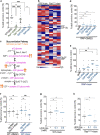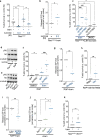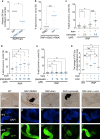This is a preprint.
Colon Cancer Cells Evade Drug Action by Enhancing Drug Metabolism
- PMID: 38187524
- PMCID: PMC10769412
- DOI: 10.1101/2023.12.21.572817
Colon Cancer Cells Evade Drug Action by Enhancing Drug Metabolism
Update in
-
Colon cancer cells evade drug action by enhancing drug metabolism.Oncogene. 2025 Sep;44(36):3284-3296. doi: 10.1038/s41388-025-03472-3. Epub 2025 Jul 10. Oncogene. 2025. PMID: 40634495 Free PMC article.
Abstract
Colorectal cancer (CRC) is the second most deadly cancer worldwide. One key reason is the failure of therapies that target RAS proteins, which represent approximately 40% of CRC cases. Despite the recent discovery of multiple alternative signalling pathways that contribute to resistance, durable therapies remain an unmet need. Here, we use liquid chromatography/mass spectrometry (LC/MS) analyses on Drosophila CRC tumour models to identify multiple metabolites in the glucuronidation pathway-a toxin clearance pathway-as upregulated in trametinib-resistant RAS/APC/P53 ("RAP") tumours compared to trametinib-sensitive RAS G12V tumours. Elevating glucuronidation was sufficient to direct trametinib resistance in RAS G12V animals while, conversely, inhibiting different steps along the glucuronidation pathway strongly reversed RAP resistance to trametinib. For example, blocking an initial HDAC1-mediated deacetylation step with the FDA-approved drug vorinostat strongly suppressed trametinib resistance in Drosophila RAP tumours. We provide functional evidence that pairing oncogenic RAS with hyperactive WNT activity strongly elevates PI3K/AKT/GLUT signalling, which in turn directs elevated glucose and subsequent glucuronidation. Finally, we show that this mechanism of trametinib resistance is conserved in an KRAS/APC/TP53 mouse CRC tumour organoid model. Our observations demonstrate a key mechanism by which oncogenic RAS/WNT activity promotes increased drug clearance in CRC. The majority of targeted therapies are glucuronidated, and our results provide a specific path towards abrogating this resistance in clinical trials.
Figures





References
-
- Cagir A. & Azmi A. S. KRAS G12C inhibitors on the horizon. Futur. Med Chem. 11, 923–925 (2019). - PubMed
-
- Caponigro G. & Sellers W. R. Advances in the preclinical testing of cancer therapeutic hypotheses. Nat. Rev. Drug Discov. 10, 179–187 (2011). - PubMed
-
- Holohan C., Schaeybroeck S. Van, Longley, D. B. & Johnston, P. G. Cancer drug resistance: An evolving paradigm. Nat. Rev. Cancer 13, 714–726 (2013). - PubMed
Publication types
Grants and funding
LinkOut - more resources
Full Text Sources
Research Materials
Miscellaneous
